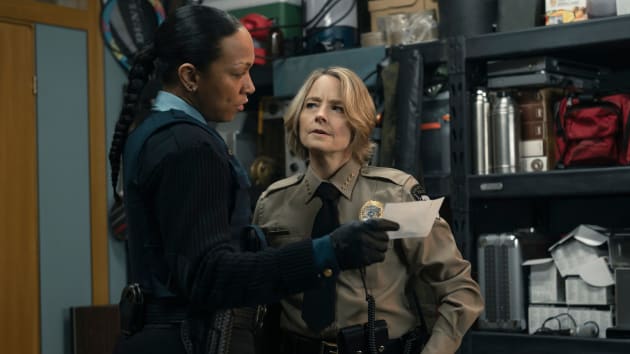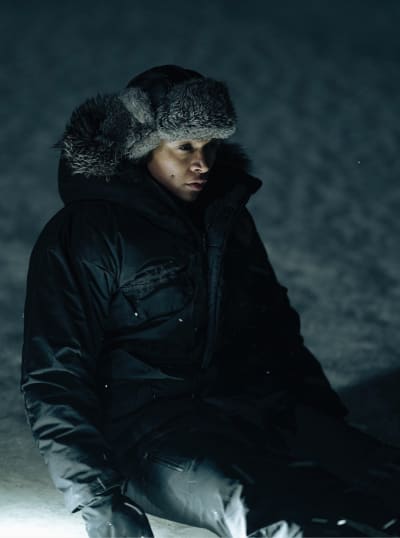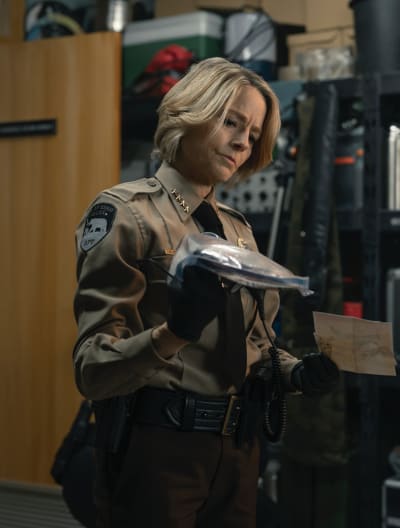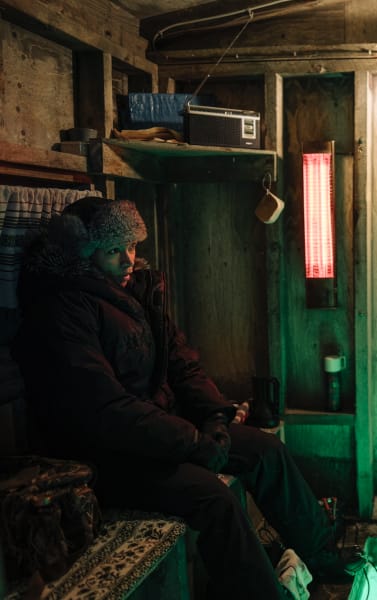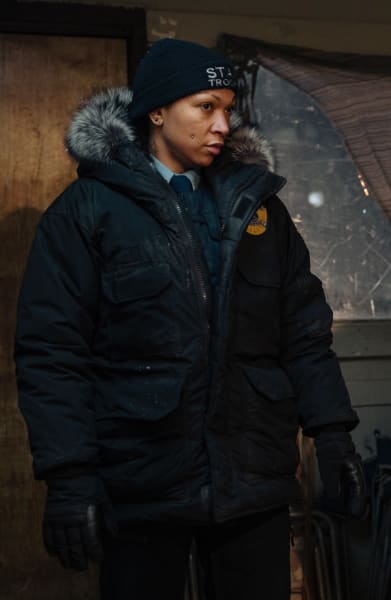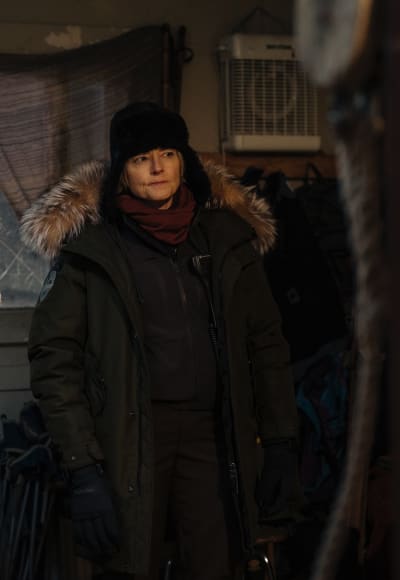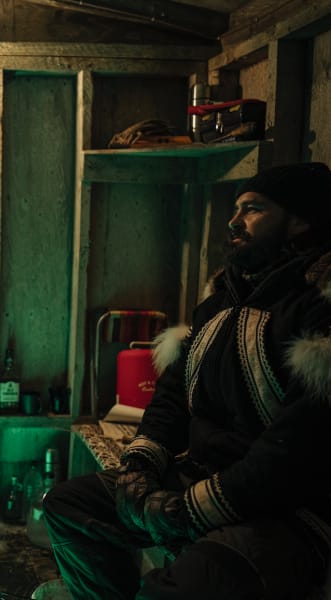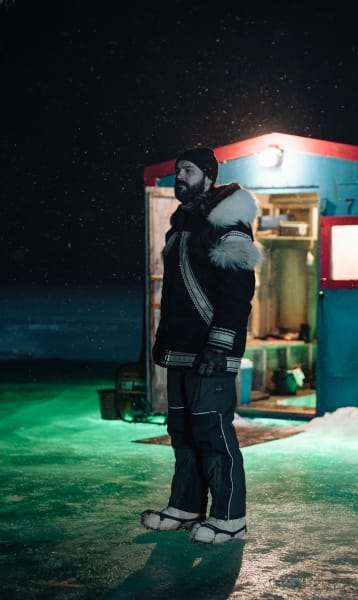As we’ve previously discussed, True Detective Season 4 has taken on an awful lot in terms of plot, theme, character development, and just about every other aspect of storytelling.
In fact, if someone asked what this series is about, you could play it safe and say, “A murder investigation in Alaska,” or you could go the pretentious route and say, “Everything.”
The latter response might be a little smug, but it’s just as accurate. Folks, this show is the anti-Seinfeld!
Race, class, religion, the never-ending war between the sexes, and the very origins of human life were all topics that came up for discussion in the first two episodes of Issa Lopez’s wildly ambitious crime drama.
And True Detective Season 4 Episode 3 maintains that focus on the big picture approach with an opening scene in which Annie K. is acting as midwife while a native woman gives birth.
Navarro shows up to serve a warrant for Annie’s anti-mine activities, and she winds up lending a hand, fetching warm water at Annie’s instruction.
Yes, the ill-fated Tsalas guys were researching the origins of human life by digging into the ice, and Annie is helping bring about a new human life with the aid of warm water.
What does it all mean? Maybe nothing! Maybe everything!
After helping the baby draw its first breath, Annie calmly offers herself up for arrest.
It’s a scene that contrasts sharply with the one that follows.
As we return to the scene of the corpsicle (we’re forever grateful to this show for introducing that word to the lexicon), Hank Prior is rounding up a gang of well-armed ruffians to assist with his search for Raymond Clark (now an official suspect).
From Iñupiaq women peacefully welcoming a new life give way to angry white men looking for something to kill.
No one will ever accuse True Detective: Night Country of being overly subtle, but there’s no denying that the juxtaposition is a powerful one.
After some more of Danvers‘ misanthropic huffing and puffing, during which she declares her hatred of literally everyone (again, this series is not concerned with nuance), she finally agrees to disclose the cause of her hatred for Navarro.
It’s all about the Wheeler case, she explains. As it turns out, Wheeler was a very bad guy, and the case in question involves his abuse and eventual murder of an 18-year-old girl.
Now, series creator Nic Pizzolatto says he’s not a fan of the current season of True Detective, but new showrunner Issa Lopez is clearly a devotee of his work.
The Wheeler murder scene is shot in a style so reminiscent of True Detective Season 1 that if we’d only seen a screenshot, we’d think it had been lifted from the saga of Hart and Cohle.
That’s probably by design, as Lopez has made it clear that she intends to tie this season into the show’s first.
And why does Danvers lie and tell Peter Prior that Wheeler had already killed himself when cops arrived on the scene?
For now, that’s another layer of mystery in a show that’s already sporting quite a few — arguably too many!
We’re just not asking the right questions. We will. We’ll find it.
Danvers
Danvers proceeds to tell Peter that Navarro transferred because of the Wheeler case, and she makes no mention of their rift over the Annie K. investigation.
And, of course, Peter lets Danvers believe he got the mark on his face from a slip-and-fall, and not from a run-in with his dad. For detectives, these two are easily led astray!
We get another callback to the spirals and layers imagery (and the graphics used in the opening credits) when Navarro hurls an orange into the void, only to have it mysteriously reappear at her feet.
From there, we get deeper into Pizzolatto Country as the feuding detectives pore over boxes of evidence to the strains of some gritty alt-country ditty.
And we reach that point in the narrative that will be familiar to all long-term True Detective fans — the one where the two investigators set aside their differences and start to find breaks in the case.
This time, it comes in the form of a hair dye smudge and the news that a local stylist introduced Annie to Raymond Clark.
Most of the hairdresser’s revelations don’t come as much of a surprise — Clark “fixated” on Annie’s tattoo, the two of them carried on a clandestine affair.
But she drops a bombshell with the news that an equipment manager named Oliver Tagaq left the Tsalas station just before Annie’s murder.
Again, the show telegraphs its twists a bit too much, this time with the hairdresser’s claim that Tagaq isn’t “looking to be found.”
They might as well have named the guy Accomplice Jones.
Just as we’re recovering from the Tagaq twist, Lopez throws us another curveball with the revelation that Hank Prior knew about the connection between Annie and Clark.
As Danvers and Navarro argue about theories, the show does an effective job of underscoring the differences between the two cops:
Danvers has both feet planted in the material world and is quick to dismiss any sort of supernatural explanation. Navarro, on the other hand, is open to any possibility.
And it’s not just their approaches to the case that differ:
When Danvers is lonely, she goes on Tinder, while Navarro prefers to pray.
Danvers: Are you kidding me? You talk to God?
Navarro: No. I listen.
It’s a dynamic that does as much as anything else to bring to mind the Season 1 and the thorny relationship between Hart and Cohle.
Eventually, True Detective: Night Country might be forced to side with one of them and choose which approach it wants to take to its resolution.
Are we dealing evil men or supernatural forces here?
Speaking of evil men, Hank digs into his role as this season’s secondary villain (or tertiary, depending on how many killers are still out there) by accusing Danvers of carrying on an inappropriate relationship with Pete.
It’s deeply satisfying when Danvers throws a cup of tea in his face, but the scene also serves as a reminder that as we reach the halfway point of True Detective Season 4, this show has a lot of loose ends to wrap up.
Toss in Hank’s mail-order bride and Peter’s tempestuous relationship with his baby’s mother, and the Prior family could fuel an entire series on their own!
Navarro’s revelation to Qavvik that her mother was murdered and the killer was never found should probably feel more monumental, but the subsequent scenes involving Leah and Jules combine to create the impression of the past closing in an impressively eerie way.
The murders, mine, the protests, the political strife within the town, Navarro’s combat trauma, the fact that Navarro never learned her Iñupiaq name:
For the first time, it feels like they’re converging into something bigger than all of them, becoming part of the same cohesive narrative.
There are some breaks in the case, as Pete’s veterinarian cousin confirms that the Tsalal men died before they froze, and Navarro exploits her local connections to track down Tagaq.
This is not how you die in the cold. It’s just not.
Vince
And in one short scene, Tagaq proves himself to be a rather complex figure.
He has knowledge of Navarro’s past, and he’s devastated to learn about the deaths of the Tsalal men.
But like so many other locals — Iñupiaq or otherwise — he’s deeply suspicious of the police and would rather run them off with a shotgun than assist in an investigation.
There’s another convenient break in the case — hey, we are approaching the halfway point of this investigation! — as the surviving Tsalal scientist, Dr. Anders Lundt awakens.
What initially seems to be a midseason deus ex machina quickly reveals itself to be arguably the most chilling scene in the history of True Detective. Or is it the corniest?
We suppose that depends on the viewer’s sensibilities.
If you like your pulpy noir served with a generous side of supernatural terror, then the disfigured Lundt informing Navarro — in a Bela Lugosi accent, no less — that her dead mother has been asking about her.
If you prefer a more terrestrial approach, then the dying scientist repeating this season’s “She’s alive!” mantra might have prompted you to give up on this season.
Lopez doubles down moments later, going full found footage horror courtesy of the last video taken on Annie Kowtok’s phone.
The showrunner is clearly as influenced by John Carpenter as she is by Pizzolatto, and she’s sprinkled some David Lynch on top for good measure.
Like her lead characters, Lopez seems to be taking multiple approaches to this investigation.
In Night Country Part 3, she refocuses the narrative by opening and closing with scenes of Annie K., while also introducing otherworldly elements that leave the audience more baffled than ever.
Against all odds, this multi-pronged approach has yielded compelling results thus far.
But the show is reaching the point where it will need to stop introducing new wrinkles to the case and instead begin the process of gathering the existing elements into something more comprehensible.
And while Lopez has thus far demonstrated tremendous talent for avoiding predictability traps, her biggest challenge — delivering a rewarding conclusion — still lies ahead of her.
Tyler Johnson is an Associate Editor for TV Fanatic and the other Mediavine O&O sites. In his spare time, he enjoys reading, cooking, and, of course, watching TV. You can Follow him on X and email him here at TV Fanatic.
